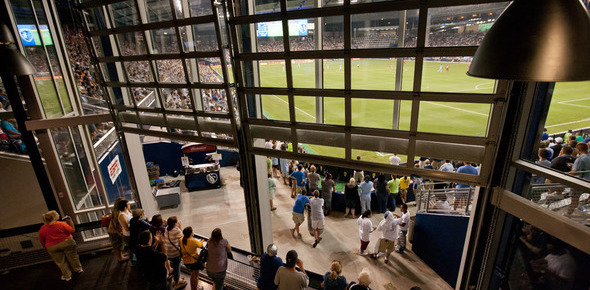The future of the fan experience- Richard Breslin & Brian Mirakian
October 31, 2012
A few months ago we looked at how Populous Activate is helping brands within the Sports and Entertainment world engage with their customer base in the UK, and considered how activation around O2 Arena changed the expectation parameters forever for both the fan and the sponsor. Today we examine the same issue in the US. My colleague, Brian Mirakian, looks at how Populous Activate is growing to meet changing fan expectations; their desire to feel both connected and engaged in an increasingly sophisticated and experiential way.
Just as our communication methods have drastically evolved over the past 10 years, so, too, have fans’ expectations of stadium design. We are increasingly interconnected, with technology and media having a pervasive effect on each of our daily lives. This has resulted in a fundamental change in the way we watch events and behaviorally, how we interact at every level within today’s sports venues. It has also impacted the way in which brands and sponsors have positioned themselves, wanting far more than two dimensional advertisements – but rather high impact, socially engaging experiences designed to connect to their audience and extend far beyond the walls of the venue. Populous Activate hones in on how experiential branded environments can engage fans more deeply, and ultimately can generate more streams of revenue. Architecture, brand activation and the fan experience are inextricably intertwined, providing the core foundation for teams to integrate themselves into the fiber of a facility and their fan community.
However, as we look forward and continually learn from analysis of fan behavioral patterns, the next generation of buildings must connect to all types of people by bridging the gap between the widening areas of fan segmentation. The traditionalist — focused on a pure, in-seat spectator experience — and the experientialist – the future fan who is continually exploring new forms of entertainment and unique places for social interaction — have inherently different needs and wants that must play an active role in the design process. One commonality is that both of these fan groups want to be connected and experientially stimulated. The design, in turn, must be one that responds to people of all generations, appealing to the traditionalist and experientialist equally and motivating both to engage without taking away from the basic spectator’s needs.
As such, technology platforms are radically informing the way we at Populous are designing buildings, dictating how we should approach fan engagement and strategically roadmap and implement brand activation. Fans’ desire for connection is more immediate than ever before – they expect an outlet for realtime dialogue with the team, fellow fans and brands unlike anything we could have anticipated before the days of Facebook and Twitter. At the same time, technology has evolved, as HD and 3D broadcast technology have catapulted the broadcasting popularity of sports to an all-time high by bringing fans closer to the game than ever before without ever leaving their homes.


